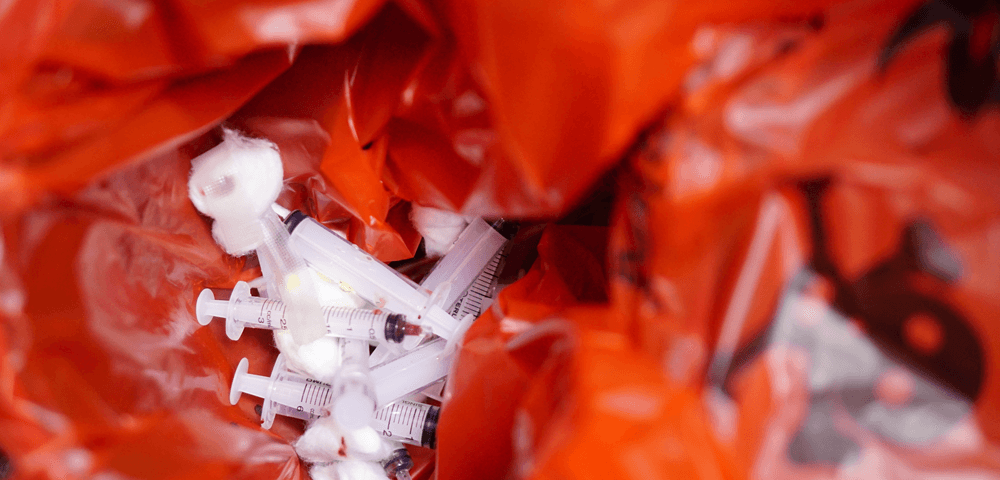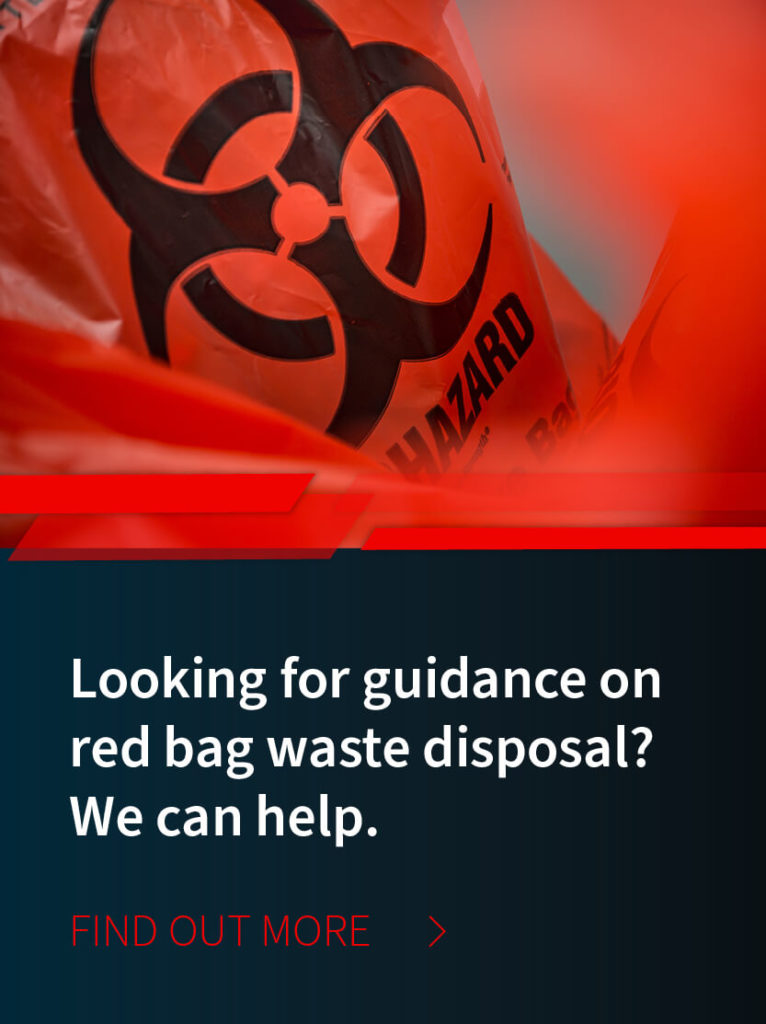
/ IN THIS BLOG
The healthcare industry produces roughly 660 tons of medical waste every day or 4 billion pounds annually throughout the country. In other words, it is estimated that every routine hospital patient produces about one pound of medical waste, per day. Roughly 15% of that waste is hazardous.
Dealing with medical waste and transportation requires awareness, implementation of best practices, and compliance with federal, state, and local laws. With so many different types of potential medical waste streams (such as sharps, biological, infectious, pathological, pharmaceutical, etc.) and with different rules and regulations stipulating how each of those types of waste needs to be handled, it can quickly become confusing.
Adding to the stress of compliant and safe disposal is the fact that improper handling carries real consequences. Improper medical waste disposal (of any kind) can have a negative impact on the environment, such as contamination of groundwater to public endangerment if there's an accident or spill involving hazardous materials.
Non-compliant medical waste disposal and transportation processes also increase the risk of fines and penalties for a medical waste generator. With that in mind, we’ve identified four best practices for safe and legal disposal and transport of medical waste.
01 / Use of Proper Medical Waste Containers are Crucial
While identification and segregation of medical waste streams is the starting point for medical waste management, it’s important to know every step of the process. For example, from disposal of waste as close to the point of generation as possible to the proper guidelines for packing, labeling, and shipping or transportation of waste off-site, every step is crucial.
Healthcare professionals and janitorial or housekeeping staff must be educated and trained in not only accurately identifying waste streams as well as how to safely handle each and then dispose of in compliant containers prior to shipping or transportation off-site for disposal. One item that can be overlooked is using the right container for the right waste stream. For example:
The contingency plan should also include contact information for all designated emergency coordinators as well as a list of emergency equipment at the facility, along with descriptions and capabilities of that emergency equipment - such as fire extinguishers, spill containment and disinfectant tools or equipment, and necessary personal protection equipment (PPE).
Preparation is the best way to combat the negative effects of an accident, and a contingency plan can help you do just that.
Red containers or bags for biological waste – red bins are only for biohazardous items and NOT for sharps or regular waste
Use of red or orange Sharps containers for sharps and needles, broken ampules, glass, etc.
Use of blue bins for non-hazardous pharmaceutical waste
Black bins for hazardous pharmaceutical waste (P- and U-listed drugs). Sharps with medication still contained may also be placed in a black bin.
Yellow bins for trace chemotherapy waste (only empty sharps used in chemotherapy should go in here)
In the event that other colored containers are used in any facility they should be visibly labeled or marked for easy identification!
02 / Proper Packing and Packaging Depends on Medical Waste Type
Before transportation of medical waste is even considered, all medical-related waste must be placed in approved and federally compliant containers. Depending on the type of waste, this could mean approved cardboard boxes, containers, bins or tubs. Be aware of the difference between hazardous and non-hazardous waste regulations for packaging.
For example, turn to 49 CFR §173 for packaging and shipment guidelines related to regulated medical waste. Guidelines for packaging and shipment of hazardous waste are under the purview of the Resource Conservation and Recovery Act (RCRA) found here.
In addition to the Code of Federal Regulations (CFR), the Environmental Protection Agency (DPA) and the RCRA, rules of the Department of Transportation (DOT) must also be followed.
Some may think that as long as the waste is put into any container, it suffices, but that's certainly not the case. Containers used for medical waste should be:
Taped shut before shipment. Bags within the container should also be taped.
Department of Transportation (DOT) approved.
Boxed according to DOT restrictions on weight.
Sealed properly.
Stored in a dry, secure area after being filled and while awaiting pick-up.
Accurate identification of your medical-related waste is crucial because it determines how you need to package and ship that waste. Regulated biomedical or biological waste, for example, should be placed in red bag liners. Those bags should then be placed inside adequately sealed DOT-approved containers.
Compliant sharps (contaminated needles, syringes, surgical knives, scalpels, etc.) containers should be placed in puncture-resistant containers that are also leak-proof before being put in proper medical waste container boxes. The Federal Drug Administration provides guidelines for FDA-cleared sharps containers.
This step is essential, as it protects anyone in contact with that waste from getting cut or poked with those sharps and potentially exposed to any infectious material. Even though transport drivers wear puncture-resistant gloves, these protective items aren't foolproof, and this protocol should be followed with every sharp, every time.
03 / Maintain Compliance with Accurate Paperwork
Maintaining accurate records and documentation of all medical waste produced in a facility, regardless of size, is essential. Accurate documentation is essential for generators of hazardous medical waste due to the necessity of obtaining an EPA ID number, which will be required for legal and safe operating practices.
Accurate documentation of all hazardous waste activities is also important to avoid audits and massive fines for non-compliance. In addition, hazardous waste manifests verify that all hazardous waste shipped off-site has been sent to a compliant and approved destination for disposal.
Reports from hazardous waste generators are required from the government depending on classification of the waste generator. You can also get information from your state government offices for waste management or from state environmental departments.
04 / About the Bill of Lading or the Manifest
All regulated medical waste that's being shipped needs to be accompanied by a properly filled out bill of lading. Such waste includes biomedical or ‘red bag’ waste. If this paperwork is inaccurate or missing, the liability rests with the generator of that waste. The bill of lading provides information about the shipment, where it’s going, date of pick-up, and description of materials, and so forth.
If you're looking to transport anything hazardous, which could include some pharmaceutical waste, a bill of lading is not used. Rather, you'll need a hazardous waste manifest. This document is required by the EPA and the DOT to legally transport hazardous waste.
The manifest for hazardous waste contains information about the hazardous materials being shipped, its weight or volume, the waste generator’s EPA identification number, and emergency contact numbers, as well as appropriate hazardous waste codes and so forth.
05 / Turn to an Experienced Waste Management Company for Guidance
Always work with an experienced and reputable waste management company like MCF Environmental Services that is fully certified and permitted to transport regulated and hazardous medical waste. Working with an established, reputable company also helps ensure that the waste ends up in a proper treatment facility. Because compliant disposal of medical waste is the generator's responsibility from start to finish, it’s important to work with a company that understands federal and state regulations and complies with those regulations when disposing of all medical waste and hazardous waste.
Working with a professional outfit presents numerous benefits:
The company is punctual and on time. If they make appointments, they keep them, so you never have to worry about whether the waste is actually going to get picked up or not. Some wastes can only be stored for specific lengths of time, so timely pick-ups are crucial.
You can develop a professional relationship with that company. You get to know the drivers, and the drivers gets to know your business. Therefore, they perform pick-ups without having to disrupt your workday more than is absolutely necessary.
Professional companies will do everything possible to comply with regulations, which helps legally protect your company and helps minimize the risk of anyone getting exposed, sick, or injured from that waste.
For more information about proper protocols or tips related to medical waste disposal and transportation, contact a representative of MCF Environmental Services today.
Robert Losurdo
President, COO








